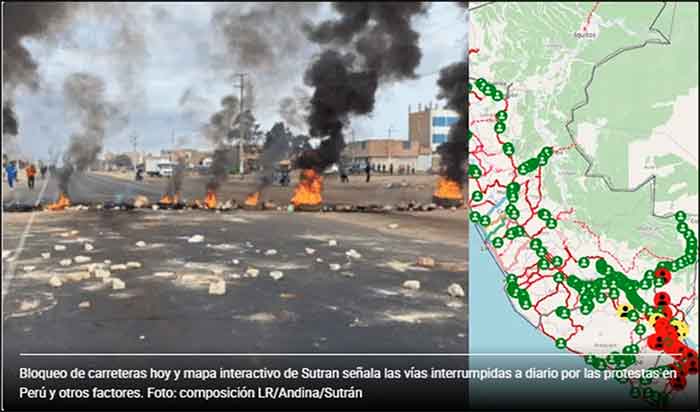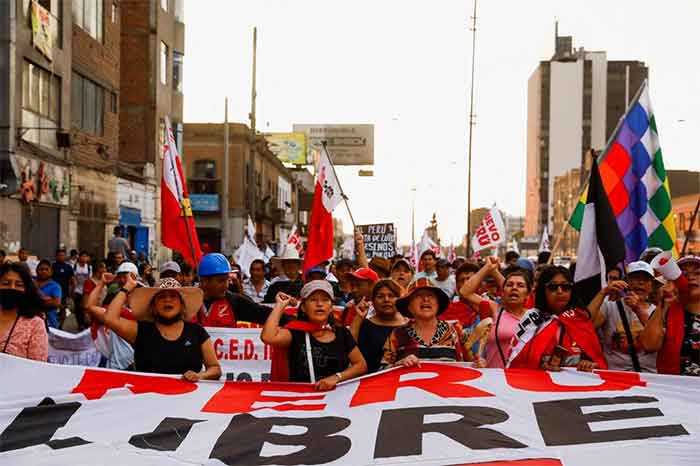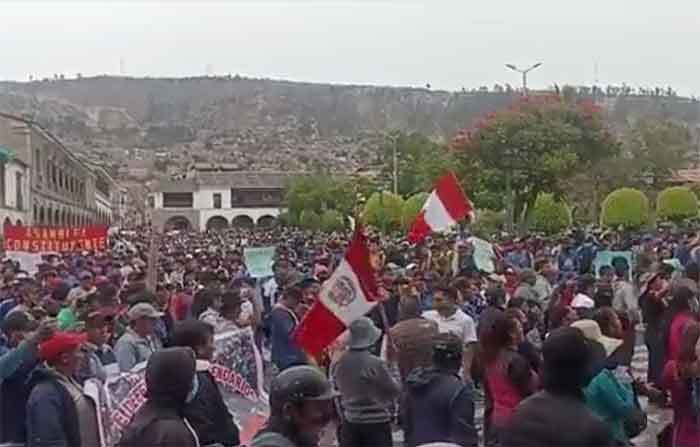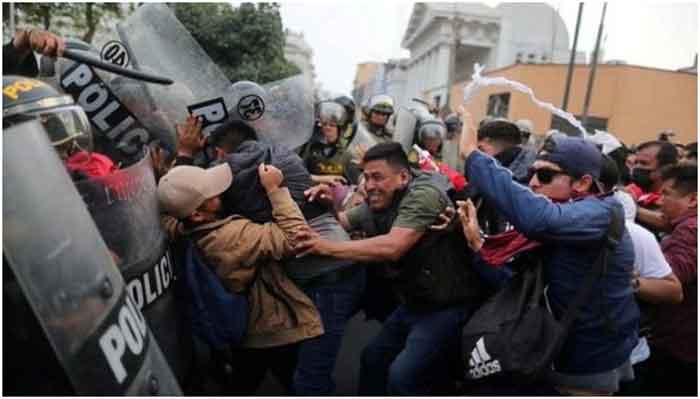Since the ouster and imprisonment of democratically elected President Pedro Castillo in Peru political crisis is prolonging in the country as people’s revolt against the rightist government is spreading across the country, and the government is increasing repressive measures instead of taking measure for a democratic approach. Daily protesters around Peru have blocked highways with trees, boulders and tires, taken over regional airports and burned buildings, impacting goods transport, business and the operation of some key mines in the world’s No. 2 copper producer.
Demonstrators are demanding the dissolution of Congress, a new constitution, and the resignation of Boluarte, who as vice president took over with Castillo was ousted.
Several attempts to pass a bill through legislature to allow early elections have failed, the latest on Friday, which blocked any further debate on the topic until August.
This was followed on Saturday by violent street protests in central Lima.
So far, 58 people including a police officer have been killed in protests that erupted after President Pedro Castillo was impeached on Dec. 7 for attempting to dissolve congress.
State Of Emergency
An AFP report said:
The government of Peru on Sunday expanded and prolonged a state of emergency to deal with a two-month-old revolt against President Dina Boluarte that has claimed many lives in clashes between protesters and security forces.
A government gazette said:
Seven southern Peruvian regions — Madre de Dios, Cusco, Puno, Apurimac, Arequipa, Moquegua and Tacna — will fall under the state of emergency measure, which will remain in place for 60 days.
On January 13, the government had extended by 30 days a state of emergency for Lima, El Callao, Cusco and Puno.
With the new extension not covering the capital Lima, nor El Callao — which hosts the country’s main airport and maritime terminals — the state of emergency there will expire in mid-February.
The measure authorizes the military to back up police actions to restore public order. It also suspends constitutional rights such as freedom of movement and assembly.
The decree provides for an 8:00 pm to 4:00 am curfew for 10 days in the department of Puno, the epicenter of the anti-government demonstrations, where 18 civilians and a policeman died in clashes on January 9.
Peru has been embroiled in a political crisis with near-daily demonstrations since December 7, when then-president Pedro Castillo was arrested after attempting to dissolve Congress and rule by decree.
Roadblocks erected by protesters have caused shortages of food, fuel and other basic commodities in several regions of the Andean nation.
The demonstrations are driven by poor southern, Indigenous Peruvians who perceive Castillo, who is also from humble origins and has Indigenous roots, as an ally in their fight against poverty, racism and inequality.
Congress Shelves President’s Bill for Early Elections
A Reuters report said:
Peru’s Congress shelved President Boluarte’s bill to bring elections forward to 2023 on Friday night, leaving a major demand of demonstrators whose protests have rocked the country in recent weeks up in the air.
Boluarte had unveiled a bill to bring elections forward to October 2023 on Wednesday in a bid to calm the deadly protests. A fractured Congress has repeatedly failed to agree on its own bill after weeks of political infighting.
A congressional commission took up the President’s bill Friday afternoon but shelved it on a technicality before it even reached debate. It cannot now be taken up again until July, when a new legislative year starts.
Rapid new elections have been a key demand of protesters since left-wing President Pedro Castillo was ousted and jailed in December after attempting to illegally dissolve Congress.
Congress had already agreed to bring forward elections originally scheduled for 2026 to 2024 but that did not halt the protests.
One bill to call elections this year by the right-wing Popular Force party failed Wednesday after days of closed door negotiations failed to yield a consensus.
Peru Libre, Castillo’s party, submitted a separate bill for early elections and a non-binding referendum for a new constitution but that was voted down Thursday night.
Other bills to bring elections forward are still in the legislative track but none have drawn consensus.
Violent Chaos Has Cost Peruvian Farms $300 Million in Lost Exports
A Bloomberg report said:
In bad news for fruit consumers, exporting powerhouse Peru has lost about $300 million in farm shipments during eight weeks of violent turmoil, according to the nation’s agricultural association.
The hundreds of highway blockades that have restricted access to ports have hurt producers of grapes, blueberries and asparagus among other products, Gabriel Amaro, head of Peru’s agricultural producers association, AGAP, said in a telephone interview.
Peru is the world’s biggest blueberry exporter, was set to become the biggest global table-grape shipper and is a major supplier of asparagus. Its fruit supplies are especially critical to the U.S., where drought and storms have damaged crops, pushing up prices.
When trucks cannot arrive because of blockades, some operations have been forced to shut plants and suspend harvesting due to insufficient refrigerated storage space, Amaro said. Some producers have tried to send trucks along unpaved tracks through the desert. Thousands of small family farms have also suffered large losses.
“Small-scale family agriculture, which supplies the local market, doesn’t normally have refrigeration,” he said. “The exporters do have refrigeration, but they can’t wait weeks and weeks without being able to use the highways.”
The blockades by anti-government protesters have paralyzed swathes of southern Peru, the nation’s mining and tourism heartland, causing large economic damage.
Congress is meeting to debate early elections as a possible way out of the crisis. Amaro’s group is calling for security forces to clear the blockades. Late last week, police pledged to do so with military support.
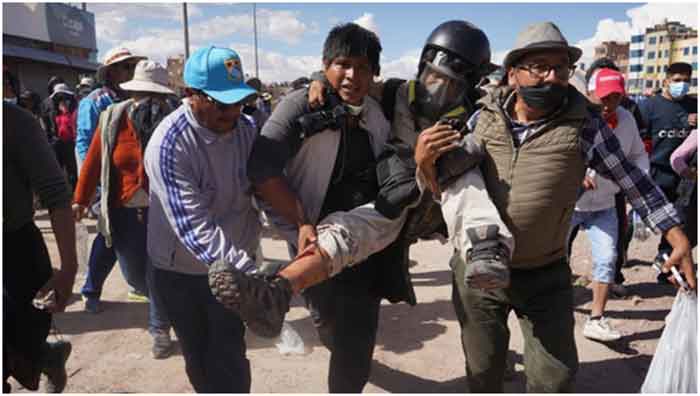
Journalists were attacked in Peru, often by Police, while covering protests. (Photo internet reproduction)
More than 150 journalists attacked in Peru, often by Police, while covering protests
A report by The Rio Times said on February 4, 2023 (https://www.riotimesonline.com/brazil-news/mercosur/peru/more-than-150-journalists-attacked-in-peru-often-by-police-while-covering-protests/):
The National Association of Peruvian Journalists (ANP) reported on Feb. 3 that 153 journalists were attacked while covering the anti-government protests that began on Dec. 7 last year, mainly in Lima, and stressed that police officers committed the most frequent attacks.
The ANP’s Human Rights Office data show that attacks on journalists totaled 94 in January, revealing that “the highest number was concentrated in Lima and that the most frequent attackers were police officers.”
The association pointed out that among the most severe incidents was the “death threat by police agents against photojournalist Aldair Mejía, of the EFE Agency, in Juliaca (Puno department) on Jan. 7.”
“In this case, hours later, the photojournalist was hit by a rubber bullet shot in the right leg, causing a bone fracture,” according to the first medical report.
It also highlighted the detention of four journalists from the southern region of Puno during a police operation at the Universidad Nacional Mayor de San Marcos in Lima, who were released 30 hours later, and the aggression against the journalistic team of the “Wayka. pe” portal, who “was not only physically assaulted by police officers, but also deprived of their work equipment.”
In addition, the ANP highlighted the “hostile aggression” to which a team of journalists from “América Televisión” was subjected when “vandals boarded” their vehicle, throwing stones and causing one of them to lose two teeth.
The ANP office pointed out that on Jan. 19, when the so-called “Takeover of Lima” was called, the highest number of attacks on journalists in a single day was recorded, with 19 attacks.
“This number surpasses the record of 16 attacks that occurred on Nov. 10, 2020, in the context of protests in defense of democracy,” it said.
The association reaffirmed its vigilant role in recording attacks on media professionals and activating, with the public and civil society organizations, measures for prevention, defense, and action in the face of these events.

